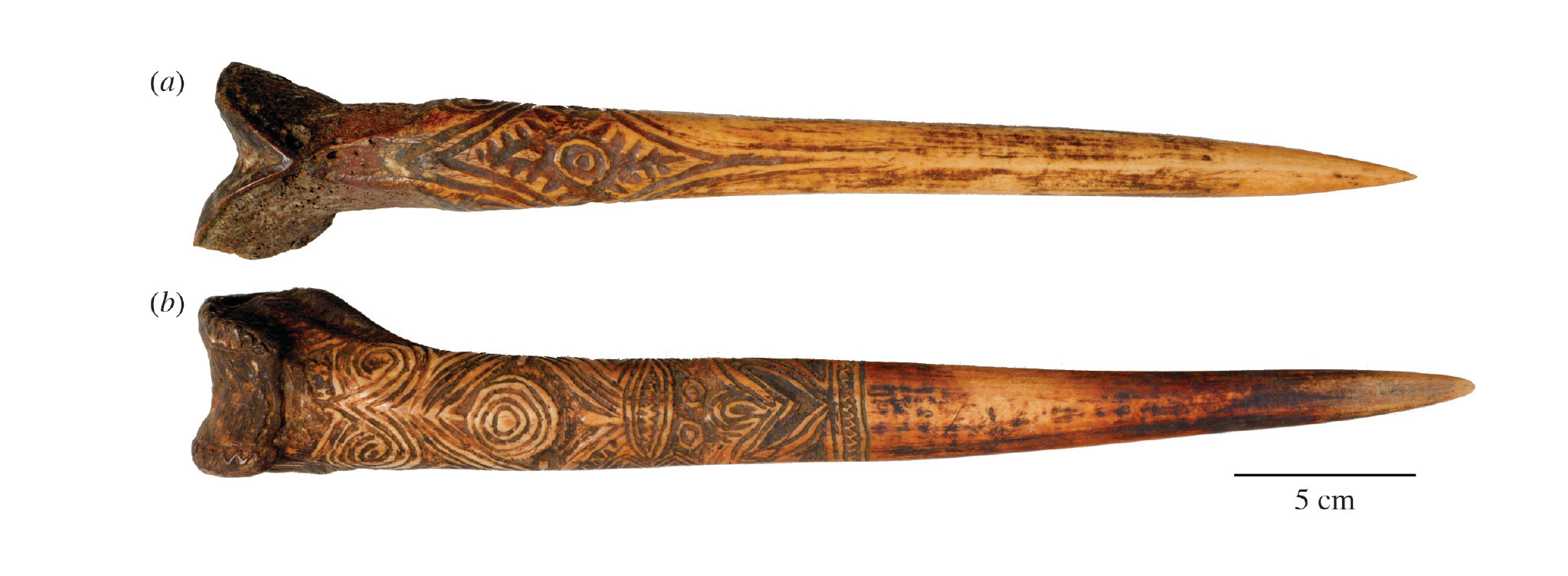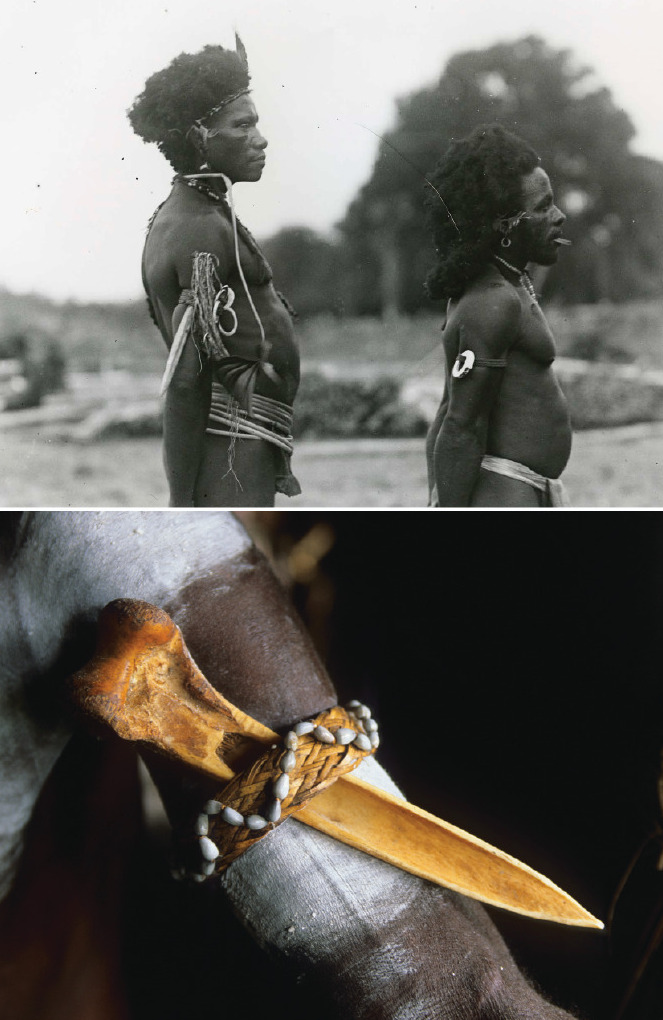Up until the 20th century, the use of bone daggers among the Papuan males of New Guinea was commonplace. Many of these daggers were forged from the femurs of large birds, but some were made from the bones of humans. New research shows which of the two materials provided for a superior dagger, demonstrating that, for Papuan men, it wasn’t the strength of the blade that mattered – but rather the prestige bestowed by the weapon.
Papuan bone daggers had both utilitarian and symbolic purposes; they were at once a formidable close-contact, hand-to-hand weapon, as well as a powerful indicator of male social status, featuring beautiful and ornate markings. New research published today in Royal Society Open Science shows that Papuan men were more interested in preserving the prestige aspect of the bone daggers than ensuring their functional aspects, a surprising result given the life-and-death stakes involved.

A decorated human bone dagger (top) and a decorated cassowary bone dagger (bottom)Image: Hood Museum of Art, Dartmouth College
Bone daggers were used mainly during the late 19th century and early 20th century. These weapons weren’t specific to a single group of people, and were primarily made from the leg bones of large, flightless birds, including cassowaries in New Guinea, now-extinct moas in New Zealand, and emus in Australia. But some bone daggers were forged from the femurs of respected men, especially those sourced from battle-proven warriors. On occasion, a son inherited the femur from his fallen father, but not until the body had decomposed to a skeletal state. The daggers made from human bone thus carried tremendous social prestige, featuring elaborate designs and worn as a conspicuous personal accessory.
Bone daggers may have been objects of artistic expression and indicators of social status, but they were important close-combat weapons, too. As weapons, they were used to either kill or finish off victims, typically by stabbing them in the neck after they were wounded by arrows or spears. Writing in 1914, German explorer Schultze Jen described its use:
The lethal point at which one aims [the bone dagger] is the neck just above the breastbone end of the collarbone, the area of the subclavia and carotid. The dagger serves not only to stab into the main arteries but at the same time as a lever with which one twists the punctured neck of the enemy in order to tear the throat and, with sufficient power, break the neck.
The puzzle for anthropologists was in understanding why some bone daggers were made from cassowary shin bones while others were made from human thigh bones. Prior to the new study, it was unknown if daggers made from human bones were stronger or weaker than those made from bird bones, but given the dual purpose of the daggers, it was also possible that the social prestige of human bone trumped its functional value.

Examples of the bone daggers worn as personal adornments.Image: Dominy et al., 2018
To understand which material was superior, a research team led by Nathaniel Dominy from Dartmouth College performed a physical stress tests on a cassowary bone dagger acquired from a private art dealer, and virtual stress tests on 11 simulated bone daggers modelled after real ones housed at the Hood Museum of Art at Dartmouth.
“We slowly bent the cassowary bone dagger until it broke. All the while, we measured how the bone resisted breaking,” Dominy told Gizmodo. “We used this information and published information in a computer model to estimate how each bone dagger in the Hood Museum would respond to different kinds of stresses. We discovered that the human bone daggers are mechanically superior to the cassowary bone daggers.”
Specifically, the models showed that bones from humans and birds shared similar physical properties, but the human bones showed greater resistance to bending; they also retained a bigger curve, suggesting a deliberate design feature to produce a stronger bone dagger. Further analysis indicated greater resistant to large loads, and with the dagger exhibiting fewer structural failures. Weirdly, however, the results showed that the cassowary bone daggers were deliberately engineered by the Papuans to be weaker.
“We speculated that a flatter shape [of the cassowary bone] is more comfortable when wearing the dagger on your bicep. Another possibility might be less friction when inserting the dagger into a victim,” said Dominy. “All things being equal, one would expect men to optimise the mechanical performance of all daggers because their lives are at risk, but they don’t. Instead, their goal seems to be the preservation of social prestige; suitable human bone daggers were rare, and preferably from the father.”
In other words, the daggers weren’t optimally designed for killing – they were designed to last. And if the daggers were made from human bone, all the better due to their structural superiority. Sounds odd, but this observation jibes well with a concept scientists call “signalling theory.”
“In anthropology, there is longstanding debate over why humans decorate utilitarian objects, such as their own bodies, clothes, pots, and so on,” explained Dominy. “One idea is that such decorations accrue prestige because they are signals of [desirable] traits to potential mates or allies.”
The discovery here, he says, is that even an object of art with a single function – in this case, an object that kills people – can be accommodated by this theory.
“Men engineered bone daggers differently despite a single common purpose, which was to kill men during hand-to-hand fighting,” said Dominy. “The leg bones of humans and cassowaries have similar material properties, so they are equally good for making daggers, but men engineered human bone daggers to better resist breakage, probably because they carried far more prestige — what social anthropologists call ‘symbolic capital’.”
A good analogy to the current era would be a Timex watch purchased from Sears as opposed to a Rolex inherited from a parent. They both tell time, but the inherited Rolex, with its high intrinsic value, would motivate the owner to buy a high-quality band as insurance against loss. Human cultures may be separated by time and geography, but it’s always fascinating to see examples that bind us together.
